
by Christina Waters | Jun 13, 2017 | Art, Home, Travel |
Here was a long-awaited experience—the chance to finally see the great Pontormo Visitation along with Bill Viola‘s haunting video response made five hundred years later. There in a single darkened room was the newly-restored Mannerist painting portraying the moment when Mary reveals to her cousin Elizabeth that she is pregnant. All the mystery and innuedo, the pungent psychological drama of what might have transpired is captured in their complex gaze, the swirling folds of the gowns, the torque of the bodies as they touch and yet turn away. Pontormo’s use of a single model for two of the figures adds a sparkle of surrealism to the moment. Mary’s mother Anne watches on, and an angel—also a witness—looks directly at us, viewers across the centuries.
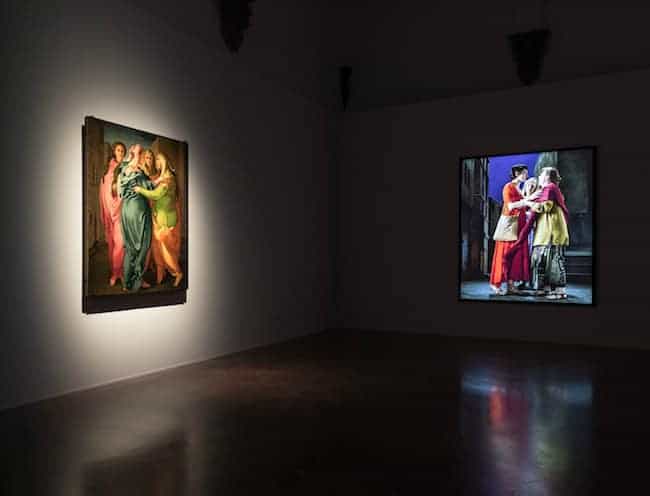 On the adjacent wall, Viola’s larger-than-lifesize figures strain against time and space in hyper slow motion, re-imagining the meeting (the piece is called The Greeting) among Mary, Elizabeth, and a third woman. Gracefully surging skirts, arms reaching out, hands about to clasp, faces registering surprise, delight, and puzzlement, Viola’s work—which takes time to unfold— forces us deep into and beneath the minds of his subjects.
On the adjacent wall, Viola’s larger-than-lifesize figures strain against time and space in hyper slow motion, re-imagining the meeting (the piece is called The Greeting) among Mary, Elizabeth, and a third woman. Gracefully surging skirts, arms reaching out, hands about to clasp, faces registering surprise, delight, and puzzlement, Viola’s work—which takes time to unfold— forces us deep into and beneath the minds of his subjects.
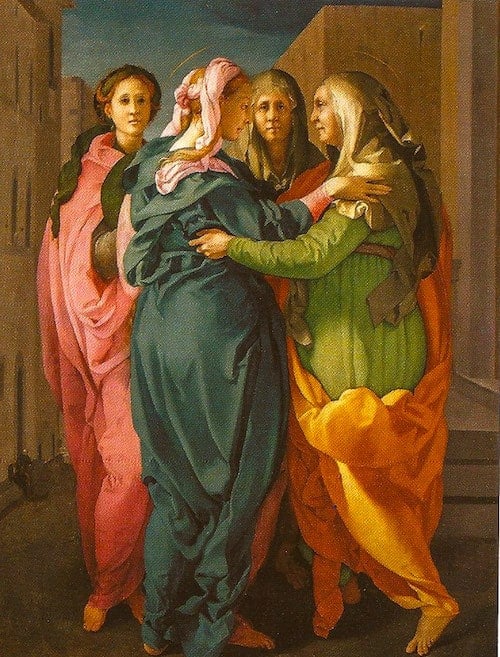 The slowed-down movements and gestures cast digital congianti onto the image painted by Bronzino’s teacher in the early 16th century. Movement inflects stillness with layers of temporal depth. Absolutely stunning. Viola’s forensic probing of an emotion-drenched moment retrieves fresh sensations we can almost taste.
The slowed-down movements and gestures cast digital congianti onto the image painted by Bronzino’s teacher in the early 16th century. Movement inflects stillness with layers of temporal depth. Absolutely stunning. Viola’s forensic probing of an emotion-drenched moment retrieves fresh sensations we can almost taste.
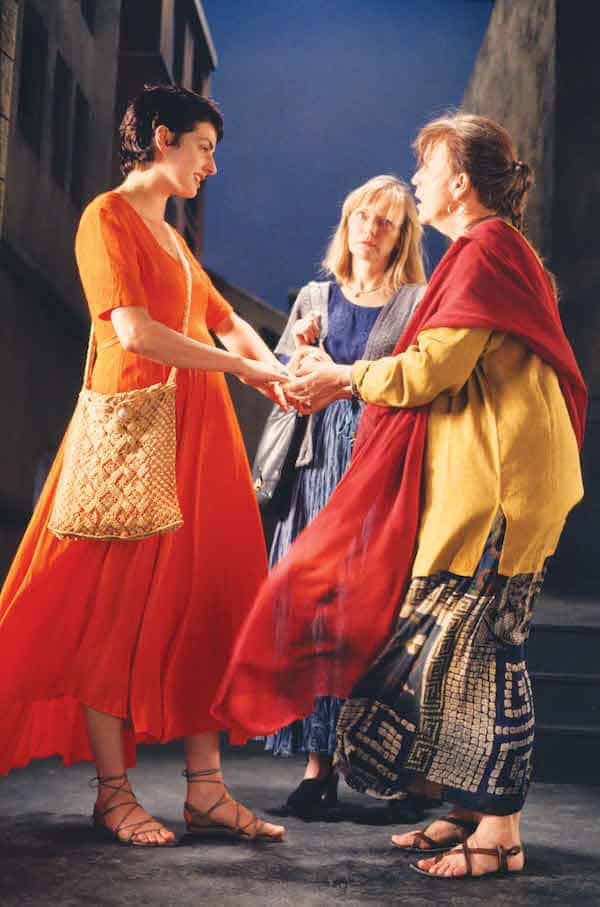 The Pontormo is triumphant, its colors brilliant as if freshly painted. A commanding palette of draped robes challenges the crimson dress worn Viola’s Mary, the magenta shawl of Elizabeth.The two works now share a secret, at once timeless and yet produced across and through time; they murmur of the same epic event. They are in league with each other. Sono insieme.
The Pontormo is triumphant, its colors brilliant as if freshly painted. A commanding palette of draped robes challenges the crimson dress worn Viola’s Mary, the magenta shawl of Elizabeth.The two works now share a secret, at once timeless and yet produced across and through time; they murmur of the same epic event. They are in league with each other. Sono insieme.
I’ve taught some of the ideas and work of video artist Bill Viola in many of my courses over the past 15 years. And the more I reflect on his comments about his work, how it came into fruition, and the various influences upon them, the more my bond with his output deepens.
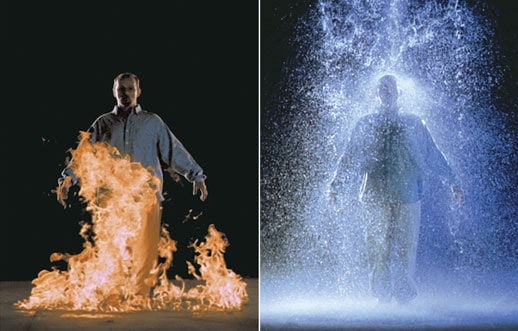 So it was with great anticipation that I took a break from operas in Vienna last month, hopped a plane across the alps, and headed for the Palazzo Strozzi in Florence. Curated with insight and largesse by Viola’s longtime collaborator and wife Kira Perov, with Arturo Galansino, the retrospective—Electronic Renaissance—honors the years Viola spent as a student and pioneer videographer in Florence. Indeed, the city opened its doors to Viola’s work, displaying pieces in multiiple sites from the Museo del Duomo to the entire Palazzo Strozzi.
So it was with great anticipation that I took a break from operas in Vienna last month, hopped a plane across the alps, and headed for the Palazzo Strozzi in Florence. Curated with insight and largesse by Viola’s longtime collaborator and wife Kira Perov, with Arturo Galansino, the retrospective—Electronic Renaissance—honors the years Viola spent as a student and pioneer videographer in Florence. Indeed, the city opened its doors to Viola’s work, displaying pieces in multiiple sites from the Museo del Duomo to the entire Palazzo Strozzi.
The real attraction for me was the chance to see Viola’s large video panels mounted in proximity with the Renaissance and Mannerist works that evoked and inspired his shimmering works. And as I had hoped, in each of the palazzo’s vaulted chambers, Renaissance works and Viola’s response faced each other, called to each other, and reinforced each other’s creative origins.
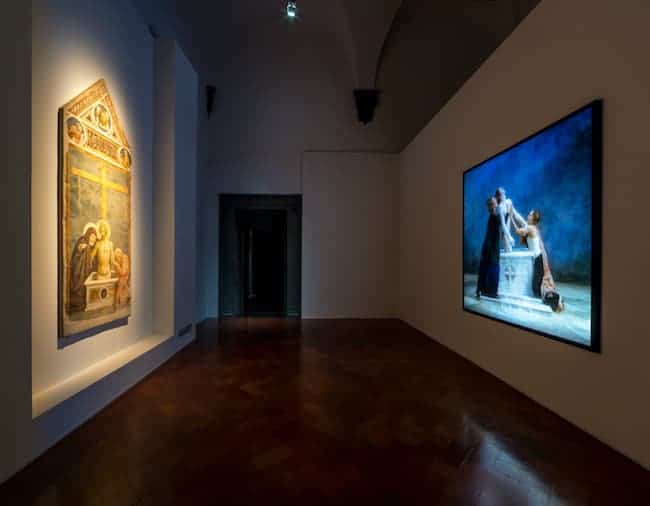 Like many of you, I had seen several of Viola’s pieces years ago at The Getty, and was familiar with his technique of hyper attenuated movement. The smallest blink of an eye, or grasp of a hand—actually happening in seconds—is stretched and lengthened into many minutes. The gestures seems to develop and bloom as we watch. Time itself unfolds through Viola’s unblinking camera, and an unseen symbolic power is revealed.
Like many of you, I had seen several of Viola’s pieces years ago at The Getty, and was familiar with his technique of hyper attenuated movement. The smallest blink of an eye, or grasp of a hand—actually happening in seconds—is stretched and lengthened into many minutes. The gestures seems to develop and bloom as we watch. Time itself unfolds through Viola’s unblinking camera, and an unseen symbolic power is revealed.
I had wandered through the cool forest of Going Forth by Day when I saw one of its five panels in Milan several years ago. Walking with the lifesized travelers of the 30 foot LED installation as they proceeded slowly across a darkened room in Florence was to enter onto a pilgrim’s journey. From room to room, I was transfixed by the glowing installations. The Crossing, one of Viola’s most famous pieces, hung suspended in the center of one huge room. On one side of the screen a man is very slowly consumed by flames as the sound system roars and crackles. On the other side, the same man is gradually, bombarded by a torrent of water, a savage deluge into which his body ultimately disappears. All that remains is the echoing of water, drop by drop. The Crossing is the most literal portrayal of Viola’s inquiry into archetypal moments of transition, of change, of ephemerality. To be human, is to be always not quite what we are. Fire and water are two moments of a single event horizon.
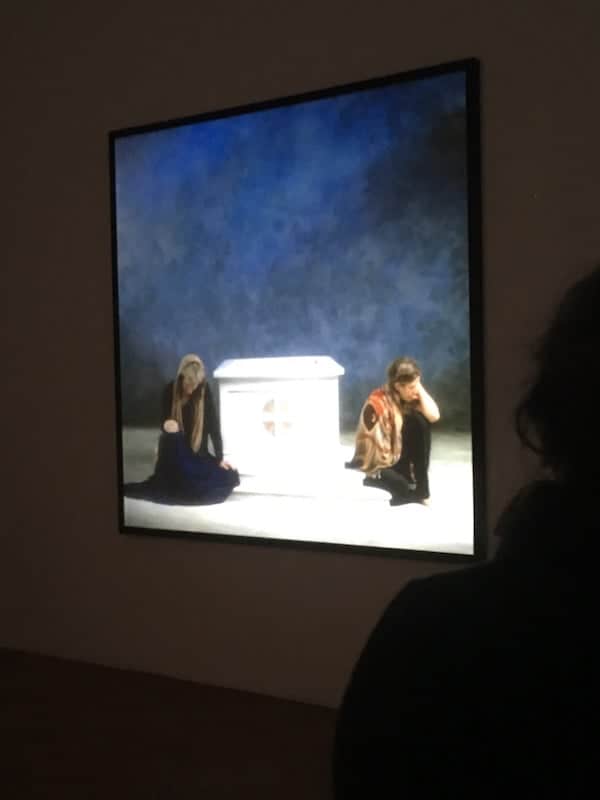 The Emergence, based upon an enigmatic and solumn 15th century work by Masolino is the exhibition’s signature work, and one in which Viola documents the naked Christ figure, emerging (as in a resurrection) and also ascending from a watery death, tenderly wrapped by two women (his mother Mary and the Magdalen, as the new testament tells it).
The Emergence, based upon an enigmatic and solumn 15th century work by Masolino is the exhibition’s signature work, and one in which Viola documents the naked Christ figure, emerging (as in a resurrection) and also ascending from a watery death, tenderly wrapped by two women (his mother Mary and the Magdalen, as the new testament tells it).
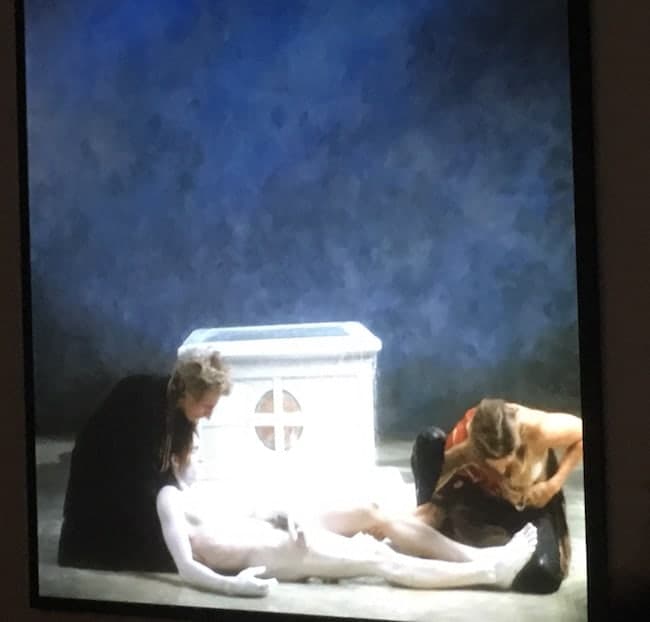 Displaying over a period of 15 minutes, the work uses its fascinating beauty (we are always wondering how it was made, noticing the arduousness of the actors’ movements) to enunciate a mysterious truth. We are watching a familiar moment, a primal moment we know in our bodies. Yet that moment has no name. It is deeper than naming. Viola knows that. The piece is nothing short of profound, kept watch over by the original Masolino alterpiece.
Displaying over a period of 15 minutes, the work uses its fascinating beauty (we are always wondering how it was made, noticing the arduousness of the actors’ movements) to enunciate a mysterious truth. We are watching a familiar moment, a primal moment we know in our bodies. Yet that moment has no name. It is deeper than naming. Viola knows that. The piece is nothing short of profound, kept watch over by the original Masolino alterpiece.
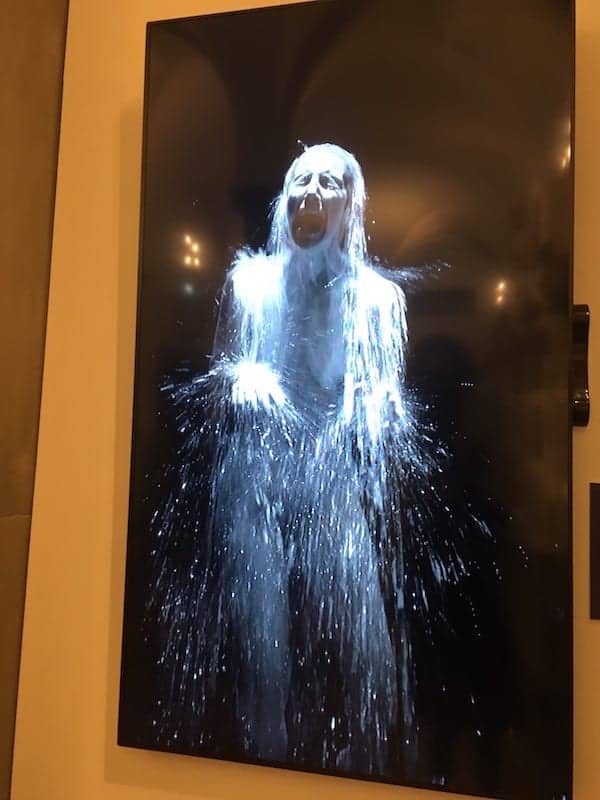 Dinner of pappardelle and wild boar ragu, chased with Chianti Classico. Next morning I saw more Viola pieces at the Museo del Opera del Duomo, and was ensnared in the tragic mirroring of Donatello‘s carved wood Magdalen—a work of numbing sorrow with Viola’s Acceptance—a lifesize video of a wailing nude woman inundated with torrents of water. The carved wooden animal hides covering the Magdalen were exactly echoed by the roiling flood, a stream of slow-motion tears. Stunned, I headed back for a second viewing of the Palazzo Strozzi show. Ten dollars was never better spent.
Dinner of pappardelle and wild boar ragu, chased with Chianti Classico. Next morning I saw more Viola pieces at the Museo del Opera del Duomo, and was ensnared in the tragic mirroring of Donatello‘s carved wood Magdalen—a work of numbing sorrow with Viola’s Acceptance—a lifesize video of a wailing nude woman inundated with torrents of water. The carved wooden animal hides covering the Magdalen were exactly echoed by the roiling flood, a stream of slow-motion tears. Stunned, I headed back for a second viewing of the Palazzo Strozzi show. Ten dollars was never better spent.
 And here I walked into my own epiphany. I moved from darkened room to darkened room on Viola’s shamanic journey. The exhibition had cast a hypnotic spell, into which I, the seeker, descended deeper and deeper until I came to the room with a piece I had known about for many years—Catherine’s Room. Five panels showing the stages of a life, the time of life (youth, middle-age, etc.) symbolized by the view of a tree outside Catherin’e window. In her youth, the tree is beginning to bloom. As she grows into maturity, the tree is seen awash with green leaves, the sun high in the sky. As she grows older, the sky outside grows darker, the tree’s leaves fall. In the final panel, we watch as she makes her bed and lies down in it pulling up the covers. The window is dark, night has fallen.
And here I walked into my own epiphany. I moved from darkened room to darkened room on Viola’s shamanic journey. The exhibition had cast a hypnotic spell, into which I, the seeker, descended deeper and deeper until I came to the room with a piece I had known about for many years—Catherine’s Room. Five panels showing the stages of a life, the time of life (youth, middle-age, etc.) symbolized by the view of a tree outside Catherin’e window. In her youth, the tree is beginning to bloom. As she grows into maturity, the tree is seen awash with green leaves, the sun high in the sky. As she grows older, the sky outside grows darker, the tree’s leaves fall. In the final panel, we watch as she makes her bed and lies down in it pulling up the covers. The window is dark, night has fallen.
 Each panel is also a video piece, so we can watch each image unfold in slow-motion time. And we can take it all in at once, embrace the entire polyptych as a whole.
Each panel is also a video piece, so we can watch each image unfold in slow-motion time. And we can take it all in at once, embrace the entire polyptych as a whole.
In the next to last panel, Catherine begins to light a large array of votive candles. One by one, each candle is patiently lit until the whole image is ablaze with flickering light. Going back and forth among the panels I suddenly realized that Viola was using his Buddhist savvy (agenda?) to reveal the life of a saint (a medieval panel of St. Catherine of Siena’s life faces the Viola installation). But he also showed me much more. All the moments, milestones, events of a human life occur simultaneously. Not sequentially. Everything is now. Change, movement, youth, age, birth, death—are all illusions, mere words. Catherine’s Room is every room. Her activities occur outside linear time.
I also realized the obviousness of my response. And its profundity.
There is more I can say about this exhibition. But for now, this will have to suffice. I’m still shaken by the effect of this particular suite of images—the past masters, and Bill Viola’s mastery.
Bill Viola:Electronic Renaissance. Through July 23, 2017 at the Palazzo Strozzi, Florence. If you’re anywhere near Italy in the next month, see this show!
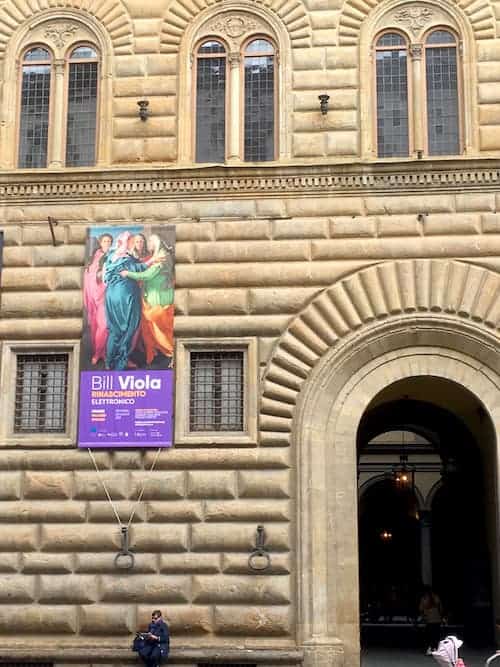
On the Other Hand
by Christina Waters | May 31, 2017 | Art, Home, Travel |
My bags are always packed!
To go from here to there is to indulge in a blend of aesthetic schizophrenia, wanderlust, and bad faith. Insisting that I love exactly where I live, I still climb onto a plane roughly once a year to become whatever the next large foreign city can make of me. Without giving up what I have, I crave what can only be gained sitting at an exotic (df. of foreign origin) table.
 The Other Place vs Home. Each has exactly what the other lacks. The foreign city has architecture, history, and the cultural depth that only a critical mass of people, talent, and creative pressure can create. [It might also offer the spectacle of Korean newlyweds posing for nuptial photos with the Uffizi in the background.]
The Other Place vs Home. Each has exactly what the other lacks. The foreign city has architecture, history, and the cultural depth that only a critical mass of people, talent, and creative pressure can create. [It might also offer the spectacle of Korean newlyweds posing for nuptial photos with the Uffizi in the background.]
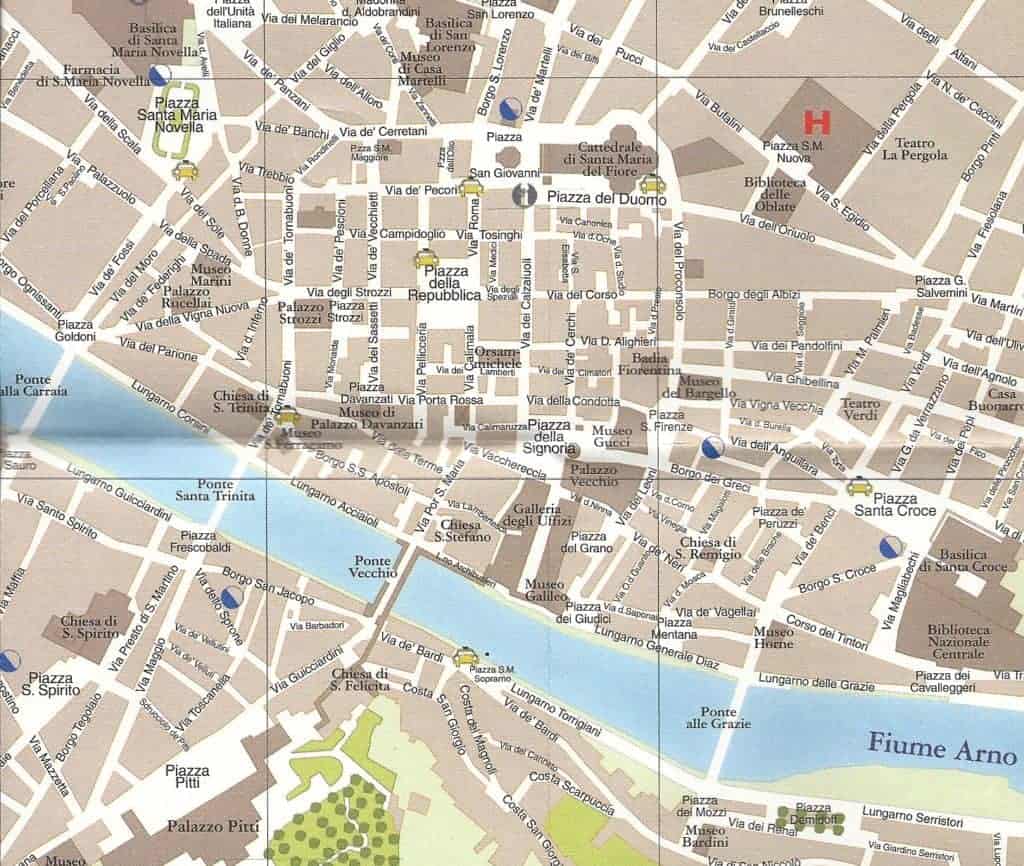    The small seaside town has coziness, hominess, familiarity. Its smaller size allows for intimacy, a sense of geographical mastery that comes with manageable scale. And it is home, a place one has lived in for years. It contains friends, lovers, colleagues—all those whose ideas and eccentricities help construct your own life.
   The small seaside town has coziness, hominess, familiarity. Its smaller size allows for intimacy, a sense of geographical mastery that comes with manageable scale. And it is home, a place one has lived in for years. It contains friends, lovers, colleagues—all those whose ideas and eccentricities help construct your own life.
Somewhere in the exact middle of these two attractive places the wanderer is suspended, not wanting to upset that balance, not wanting to have to choose.
I travel partly in order to see my home from a clearer vantage point, and nothing clarifies like distance (Antonioni knew that. So did Hemingway, and Durrell.) But also to feast and fill up upon the riches of the other—another time, another cultural sensibility, another way of moving, talking, and listening.
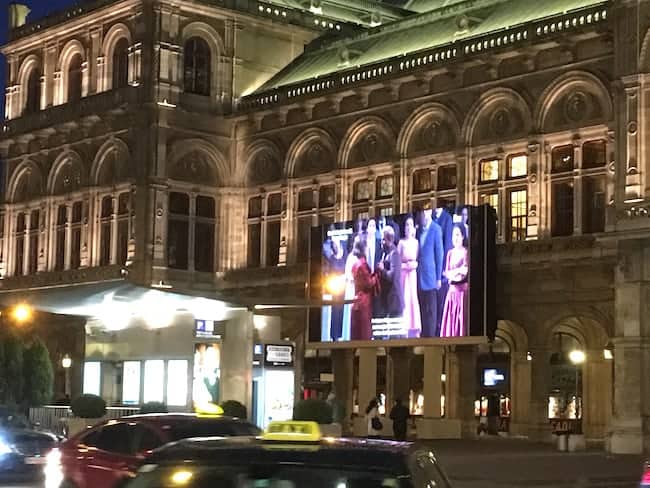 The smell of frankincense that fills the high altar of a cathedral on Sunday mornings speaks to my subconscious DNA. Was I a priest in a past life? The sound of church bells, counting out the hours, calling people to prayer, announcing this or another civic event, is part of the atmospheric soundtrack of European cities. A soundtrack missing from seaside California.
The smell of frankincense that fills the high altar of a cathedral on Sunday mornings speaks to my subconscious DNA. Was I a priest in a past life? The sound of church bells, counting out the hours, calling people to prayer, announcing this or another civic event, is part of the atmospheric soundtrack of European cities. A soundtrack missing from seaside California.
Admiring the bravura of men’s fashion in Italy I am forced to grasp the casual attire of coastal California. I see no baseball caps in Vienna, and I instantly understand the climate, the sun, the outdoor lifestyle that produces our dress code. It’s harder to see when you are in the midst, easy to spot via the extreme contrast of a metropolitan European city founded thousands of years ago by Celts.
I discovered BBC when I was in Paris several decades ago. Even though I loved French TV, the mesmerizing commercials, and pungently-dramatic soap operas, I wanted to hear some of my native language. That’s when I realized that American TV carried on as if there were no weather issues in Africa. No one mentioned incidents in the Sudan, or Myanmar. Chinese business deals weren’t given a second of air time. Bulgaria didn’t exist. The world into which I had traveled was not only larger, but my own country and its media prejudices seemed provincial by comparison.
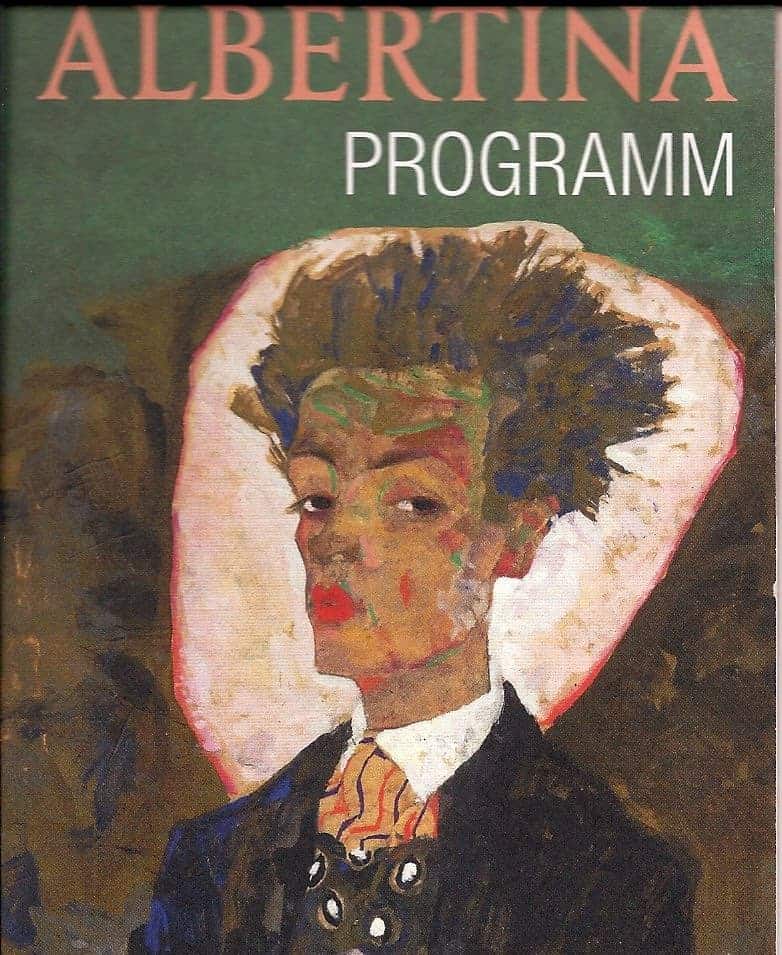 Without question we see ourselves and our cultural assumptions more clearly from afar. Travel removes me from work. I leave my laptop at home. I am frugal with my emails. Here and now details tend to define each day. I visit a museum in Florence and find it filled with engaged high school groups. I visit a Monet show in San Francisco and find it filled with white-haired nostalgics. The youthful energy and passion for the arts in Europe is both encouraging (I envy the Europeans) and sad (I am brusquely reminded of the inattention to art of the past by student-aged Americans). Yes, opera is expensive, but the queue for cheap standing room is a block-long in Vienna. All young people. Outside the US, museum tickets are inexpensive and everyone seems to take advantage of the sensory feast and stimulus to the imagination provided by innovatively-curated exhibitions. And no, I don’t mean simply parading out the content of a wealthy woman’s closet and calling it an art exhibition.
Without question we see ourselves and our cultural assumptions more clearly from afar. Travel removes me from work. I leave my laptop at home. I am frugal with my emails. Here and now details tend to define each day. I visit a museum in Florence and find it filled with engaged high school groups. I visit a Monet show in San Francisco and find it filled with white-haired nostalgics. The youthful energy and passion for the arts in Europe is both encouraging (I envy the Europeans) and sad (I am brusquely reminded of the inattention to art of the past by student-aged Americans). Yes, opera is expensive, but the queue for cheap standing room is a block-long in Vienna. All young people. Outside the US, museum tickets are inexpensive and everyone seems to take advantage of the sensory feast and stimulus to the imagination provided by innovatively-curated exhibitions. And no, I don’t mean simply parading out the content of a wealthy woman’s closet and calling it an art exhibition.
Does travel expand our consciousness? Does the Pope suffer fools?
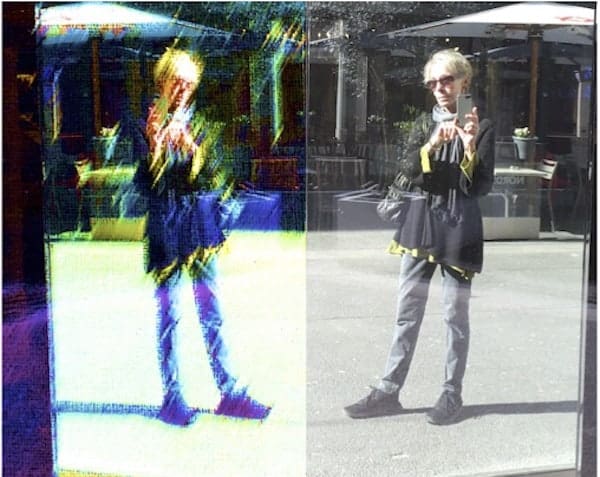
Bilocation and other travel puzzles
by Christina Waters | May 24, 2017 | Home, Travel |
Ah the unavoidable psycho-physical malaise of bilocation—the doubling of oneself that happens between travel and homecoming. Think of it as a variation on the mind/body problem.
Our body is spatially bound but our consciousness is adrift; e.g. somewhere near the Palazzo Vecchio, or gazing into the orchestra pit just before the overture begins. Our mind wanders in ways that our body cannot.
My hands have to be on a keyboard making sure I submit a story on time, but my imagination is unbounded by such constraints. While my body retains much of the sensory impressions of recent travel—the rolling vibration of a train ride, the feeling of the French horns thundering the entry of the gods into Valhalla—my thoughts and images are free to continue the sensory feast I’ve just seen, heard, tasted and felt.
 I can still taste the sour cherry gelato I had at Corona’s at the corner of the Piazza de la Republica in Florence. I use “taste” in a quasi-metaphorical, quasi-magical sense. And because I can still taste it, I can still be there, feeling the afternoon sun, hearing the bells ringing six o’clock.
I can still taste the sour cherry gelato I had at Corona’s at the corner of the Piazza de la Republica in Florence. I use “taste” in a quasi-metaphorical, quasi-magical sense. And because I can still taste it, I can still be there, feeling the afternoon sun, hearing the bells ringing six o’clock.
The sensation of being both here and there lingers as if the body had been imprinted with the entire movement, architecture, music, flavors, and visual feasts of the duration of being far away. All of it inhabits me. I bring it back when I return and try to keep it close. I recite my memories of each day of travel, everything I saw, the people I met, the wines I tasted, and as I recite these experiences—telling them to myself, and to others—I keep the illusion of “being there” intact. But soon all those pungent and vital impressions start to fade, much as footsteps in the sand gradually eroding by the force of the tides.
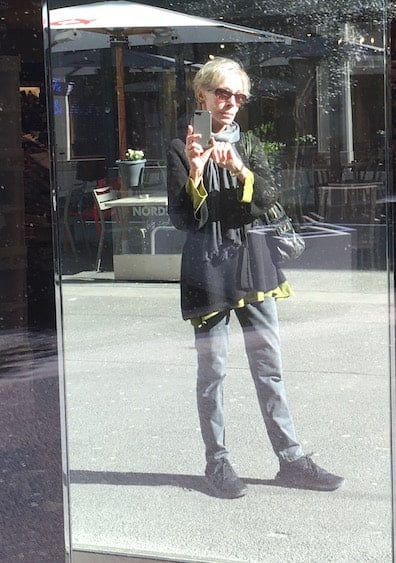 Soon the feeling of being in a single space, the place of “now” solidifies. It becomes firm. I am no longer far away, no longer in the midst of travel, I am back. I am here, in a single location. And the minute I feel that, I am corraled by a single here and present. And I ache for the freedom of travel. And I want to get back on a plane and expand myself into that other location. I want to double my self, my life, my days for as long, and as many as I can.
Soon the feeling of being in a single space, the place of “now” solidifies. It becomes firm. I am no longer far away, no longer in the midst of travel, I am back. I am here, in a single location. And the minute I feel that, I am corraled by a single here and present. And I ache for the freedom of travel. And I want to get back on a plane and expand myself into that other location. I want to double my self, my life, my days for as long, and as many as I can.
It is an ever-receding horizon. An illusion. Fata morgana.
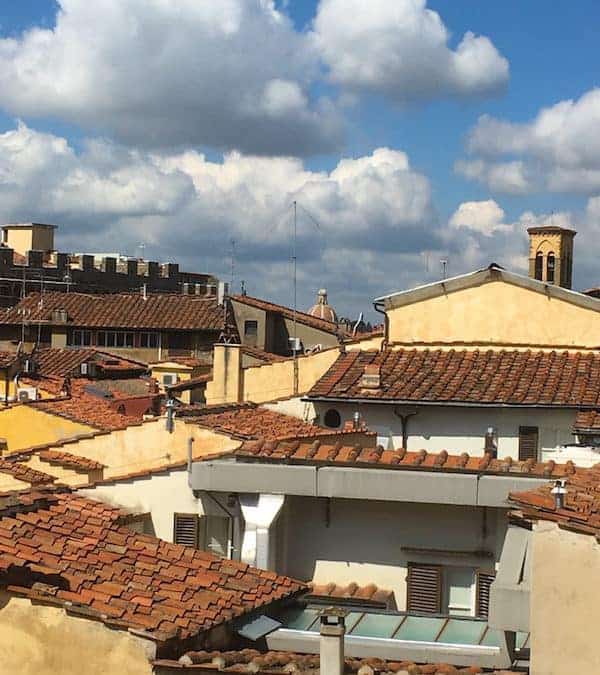
Time Travel Conflicts
by Christina Waters | May 16, 2017 | Art, Home, Travel |
There are many forms of being in conflict with oneself, but few are as universal, if irrational, as that feeling you have after a satisfying trip far away from your everyday life. For two weeks I was lucky enough to be in Vienna and, briefly, Florence. By the end of the richly rewarding journey of sensory pleasures—opera, concerts, art exhibitions, regional cuisine, architecture—it was time to come home. Yet a mere 24 hours after being back, and after soaking up the enjoyment of my sweetheart, my own bed, the foods I love….I longed to be back in a great European city that could not possibly be more different than the small seaside town in California where I live.
What is that about?
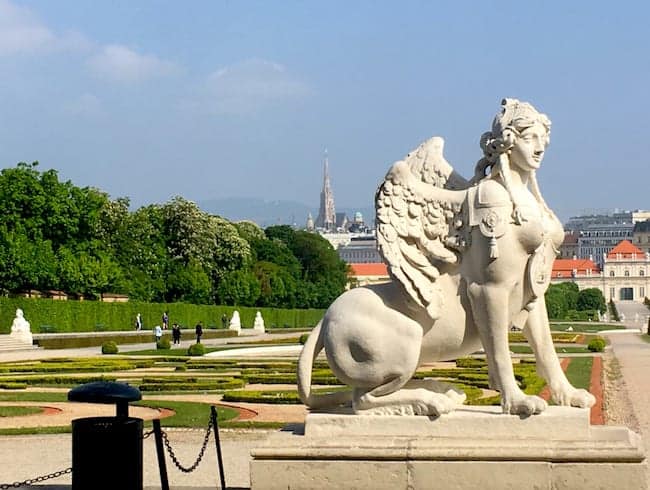 Nothing feels better than coming home after a stretch of time in which each day has required strategizing over where you will eat, whether your grasp of German and Italian (or whatever non-native language) will suffice without causing howls of derision, walking until your feet scream, struggling with jet lag, and dining with strangers or alone with only your cell phone (or a book!) for company. Being at home means never having to say “come se dice “clueless” in Italiano.” Being at home means not having to endure the specific humiliation of being handed a menu in English when you’ve worked your butt off to master restaurant German. Being at home means not having to negotiate hieroglyphic subway signage, taxi prices, the ridiculously small size of street names on maps that you’re trying not to be seen using.
Nothing feels better than coming home after a stretch of time in which each day has required strategizing over where you will eat, whether your grasp of German and Italian (or whatever non-native language) will suffice without causing howls of derision, walking until your feet scream, struggling with jet lag, and dining with strangers or alone with only your cell phone (or a book!) for company. Being at home means never having to say “come se dice “clueless” in Italiano.” Being at home means not having to endure the specific humiliation of being handed a menu in English when you’ve worked your butt off to master restaurant German. Being at home means not having to negotiate hieroglyphic subway signage, taxi prices, the ridiculously small size of street names on maps that you’re trying not to be seen using.
 But as Sartre liked to remind us, nothing makes us feel as alive as struggle. Nor does the successful result leave as lasting an impact as when we had to work for it. Adversity is bracing. And that sense of quest, of having to work for the cold beer at the top of the hill, or that first glimpse of the Duomo after a 12-hour plane trip—these are what sweeten both the present moment, and that lasting memory of travel.
But as Sartre liked to remind us, nothing makes us feel as alive as struggle. Nor does the successful result leave as lasting an impact as when we had to work for it. Adversity is bracing. And that sense of quest, of having to work for the cold beer at the top of the hill, or that first glimpse of the Duomo after a 12-hour plane trip—these are what sweeten both the present moment, and that lasting memory of travel.
 And then there’s the slammed against the wall discomfort and disarray of long-distance travel. The customs lines, the dishevelment of TSA, the spatial cram and compromise of airplane seating, the out-of-body haze of having been semi-conscious for 20 hours and then having to check into a hotel with something close to dignity. [A sidebar you’ll enjoy: as my Slovakian cabbie approached the inner city of Vienna, he was stopped at the bridge over the Donau canal. According to the polizei, all roads to the old city were closed. It was a Friday, the end of April. No explanations. My poor driver was apologetic but he had to let me out right there, with only a few indications of where I should go—straight ahead, turn right, then another left to my hotel. This is after SFO to Frankfurt, Frankfurt to Vienna, 15 hours of travel and loaded down with one huge rolling suitcase and another carry-on case. I had to actually roll both cases through the streets of Vienna, ask for directions twice, then go the long way through throngs of student tour groups and people with selfie sticks all clustered around the huge cathedral, just attempting to stay on my feet. Arms aching, utterly wiped out, I made it to my hotel. Not my best travel memory.]
And then there’s the slammed against the wall discomfort and disarray of long-distance travel. The customs lines, the dishevelment of TSA, the spatial cram and compromise of airplane seating, the out-of-body haze of having been semi-conscious for 20 hours and then having to check into a hotel with something close to dignity. [A sidebar you’ll enjoy: as my Slovakian cabbie approached the inner city of Vienna, he was stopped at the bridge over the Donau canal. According to the polizei, all roads to the old city were closed. It was a Friday, the end of April. No explanations. My poor driver was apologetic but he had to let me out right there, with only a few indications of where I should go—straight ahead, turn right, then another left to my hotel. This is after SFO to Frankfurt, Frankfurt to Vienna, 15 hours of travel and loaded down with one huge rolling suitcase and another carry-on case. I had to actually roll both cases through the streets of Vienna, ask for directions twice, then go the long way through throngs of student tour groups and people with selfie sticks all clustered around the huge cathedral, just attempting to stay on my feet. Arms aching, utterly wiped out, I made it to my hotel. Not my best travel memory.]
 There’s more to ponder here. Once jetlag and the utter exhaustion of the long flight wore off, I began to walk the streets, learn where my favorite new cafes were, meet up with fellow opera-lovers for the many evenings of great music, revisit museums I hadn’t seen since grad school. In other words, I began residency in a new world. I had carved out yet another life, a new identity in which I was psychologically at least in two places at once.
There’s more to ponder here. Once jetlag and the utter exhaustion of the long flight wore off, I began to walk the streets, learn where my favorite new cafes were, meet up with fellow opera-lovers for the many evenings of great music, revisit museums I hadn’t seen since grad school. In other words, I began residency in a new world. I had carved out yet another life, a new identity in which I was psychologically at least in two places at once.
And that may be the key to this double bind, this longing to be home while wishing to be traveling again. Going far enough away from familiar scenes that you are forced to see differently, move differently, speak differently, creates a new existence. I had extended my life by two weeks, carving out more time and more space while still being my “real” self in my “real” identity.
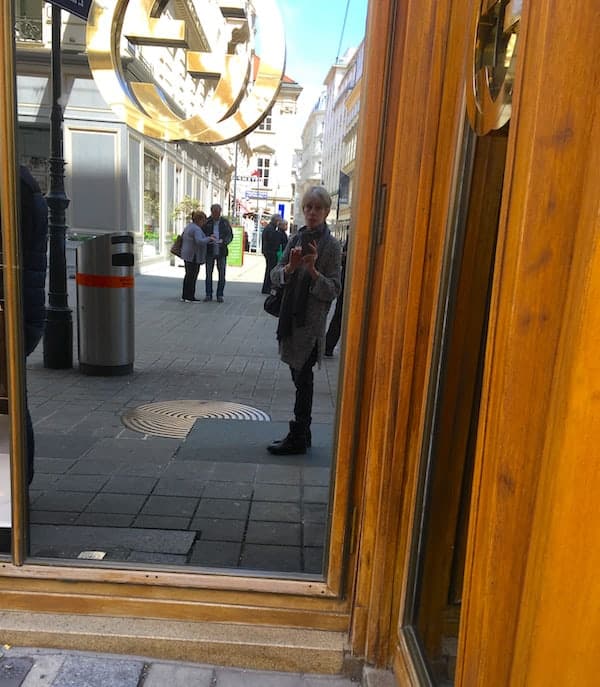 Travel gives us not only new spaces, it gives us more time. And the illusion of an expanded life. I can live in two places at once. At least for a while—as long as my feet (and my money) hold out.
Travel gives us not only new spaces, it gives us more time. And the illusion of an expanded life. I can live in two places at once. At least for a while—as long as my feet (and my money) hold out.
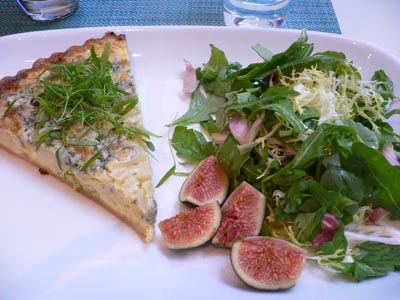
Lunch @ MOMA
by Christina Waters | Nov 17, 2011 | Home, Travel |
 The excuse was the outstanding de Kooning retrospective at New York’s Museum of Modern Art, a sleek exhibition setting that lives up to its classically modern name. But the first thing we did was head up to the 5th floor Terrace cafe for a delightfully civilized early lunch. Armed with an appropriate regional wine – a Merlot from Pellegrini Vineyards, North Fork, NY 2006 – we dove into beautiful plates of seasonal flavors.
The excuse was the outstanding de Kooning retrospective at New York’s Museum of Modern Art, a sleek exhibition setting that lives up to its classically modern name. But the first thing we did was head up to the 5th floor Terrace cafe for a delightfully civilized early lunch. Armed with an appropriate regional wine – a Merlot from Pellegrini Vineyards, North Fork, NY 2006 – we dove into beautiful plates of seasonal flavors.
For my sweetie, slices of organic chicken with marinated squashes and hearts of romaine lavished with mustardy vinaigrette. For me this warm eggy tart of roasted cauliflower and Bayley Hazen blue cheese, (more…)
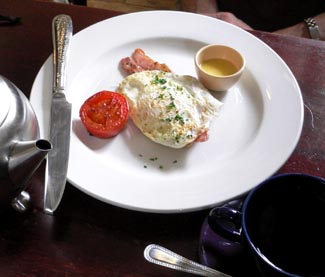
An Irish Tea Room in Bethlehem
by Christina Waters | Jun 15, 2010 | Home, Travel |
Last week we headed for the east coast and a family wedding in Bethlehem, PA, home to steel  mill ruins and an 18th century utopia built by Moravian colonists. Blindingly green, the Lehigh Valley in June can be hot and humid. And it was.
mill ruins and an 18th century utopia built by Moravian colonists. Blindingly green, the Lehigh Valley in June can be hot and humid. And it was.
But we found relief in a charming Irish team room next door to an Inn where George Washington used to hoist pints of colonial homebrew while plotting military maneuvers.
McCarthy’s Tea Room, located in the architectural center of Bethlehem, offered an authentic breakfast of eggs, on top of a slender oat cake (more…)

 On the adjacent wall, Viola’s larger-than-lifesize figures strain against time and space in hyper slow motion, re-imagining the meeting (the piece is called The Greeting) among Mary, Elizabeth, and a third woman. Gracefully surging skirts, arms reaching out, hands about to clasp, faces registering surprise, delight, and puzzlement, Viola’s work—which takes time to unfold— forces us deep into and beneath the minds of his subjects.
On the adjacent wall, Viola’s larger-than-lifesize figures strain against time and space in hyper slow motion, re-imagining the meeting (the piece is called The Greeting) among Mary, Elizabeth, and a third woman. Gracefully surging skirts, arms reaching out, hands about to clasp, faces registering surprise, delight, and puzzlement, Viola’s work—which takes time to unfold— forces us deep into and beneath the minds of his subjects. The slowed-down movements and gestures cast digital congianti onto the image painted by Bronzino’s teacher in the early 16th century. Movement inflects stillness with layers of temporal depth. Absolutely stunning. Viola’s forensic probing of an emotion-drenched moment retrieves fresh sensations we can almost taste.
The slowed-down movements and gestures cast digital congianti onto the image painted by Bronzino’s teacher in the early 16th century. Movement inflects stillness with layers of temporal depth. Absolutely stunning. Viola’s forensic probing of an emotion-drenched moment retrieves fresh sensations we can almost taste. The Pontormo is triumphant, its colors brilliant as if freshly painted. A commanding palette of draped robes challenges the crimson dress worn Viola’s Mary, the magenta shawl of Elizabeth.The two works now share a secret, at once timeless and yet produced across and through time; they murmur of the same epic event. They are in league with each other. Sono insieme.
The Pontormo is triumphant, its colors brilliant as if freshly painted. A commanding palette of draped robes challenges the crimson dress worn Viola’s Mary, the magenta shawl of Elizabeth.The two works now share a secret, at once timeless and yet produced across and through time; they murmur of the same epic event. They are in league with each other. Sono insieme. So it was with great anticipation that I took a break from operas in Vienna last month, hopped a plane across the alps, and headed for the Palazzo Strozzi in Florence. Curated with insight and largesse by Viola’s longtime collaborator and wife Kira Perov, with Arturo Galansino, the retrospective—Electronic Renaissance—honors the years Viola spent as a student and pioneer videographer in Florence. Indeed, the city opened its doors to Viola’s work, displaying pieces in multiiple sites from the Museo del Duomo to the entire Palazzo Strozzi.
So it was with great anticipation that I took a break from operas in Vienna last month, hopped a plane across the alps, and headed for the Palazzo Strozzi in Florence. Curated with insight and largesse by Viola’s longtime collaborator and wife Kira Perov, with Arturo Galansino, the retrospective—Electronic Renaissance—honors the years Viola spent as a student and pioneer videographer in Florence. Indeed, the city opened its doors to Viola’s work, displaying pieces in multiiple sites from the Museo del Duomo to the entire Palazzo Strozzi. Like many of you, I had seen several of Viola’s pieces years ago at The Getty, and was familiar with his technique of hyper attenuated movement. The smallest blink of an eye, or grasp of a hand—actually happening in seconds—is stretched and lengthened into many minutes. The gestures seems to develop and bloom as we watch. Time itself unfolds through Viola’s unblinking camera, and an unseen symbolic power is revealed.
Like many of you, I had seen several of Viola’s pieces years ago at The Getty, and was familiar with his technique of hyper attenuated movement. The smallest blink of an eye, or grasp of a hand—actually happening in seconds—is stretched and lengthened into many minutes. The gestures seems to develop and bloom as we watch. Time itself unfolds through Viola’s unblinking camera, and an unseen symbolic power is revealed. The Emergence, based upon an enigmatic and solumn 15th century work by Masolino is the exhibition’s signature work, and one in which Viola documents the naked Christ figure, emerging (as in a resurrection) and also ascending from a watery death, tenderly wrapped by two women (his mother Mary and the Magdalen, as the new testament tells it).
The Emergence, based upon an enigmatic and solumn 15th century work by Masolino is the exhibition’s signature work, and one in which Viola documents the naked Christ figure, emerging (as in a resurrection) and also ascending from a watery death, tenderly wrapped by two women (his mother Mary and the Magdalen, as the new testament tells it). Displaying over a period of 15 minutes, the work uses its fascinating beauty (we are always wondering how it was made, noticing the arduousness of the actors’ movements) to enunciate a mysterious truth. We are watching a familiar moment, a primal moment we know in our bodies. Yet that moment has no name. It is deeper than naming. Viola knows that. The piece is nothing short of profound, kept watch over by the original Masolino alterpiece.
Displaying over a period of 15 minutes, the work uses its fascinating beauty (we are always wondering how it was made, noticing the arduousness of the actors’ movements) to enunciate a mysterious truth. We are watching a familiar moment, a primal moment we know in our bodies. Yet that moment has no name. It is deeper than naming. Viola knows that. The piece is nothing short of profound, kept watch over by the original Masolino alterpiece. Dinner of pappardelle and wild boar ragu, chased with Chianti Classico. Next morning I saw more Viola pieces at the Museo del Opera del Duomo, and was ensnared in the tragic mirroring of Donatello‘s carved wood Magdalen—a work of numbing sorrow with Viola’s Acceptance—a lifesize video of a wailing nude woman inundated with torrents of water. The carved wooden animal hides covering the Magdalen were exactly echoed by the roiling flood, a stream of slow-motion tears. Stunned, I headed back for a second viewing of the Palazzo Strozzi show. Ten dollars was never better spent.
Dinner of pappardelle and wild boar ragu, chased with Chianti Classico. Next morning I saw more Viola pieces at the Museo del Opera del Duomo, and was ensnared in the tragic mirroring of Donatello‘s carved wood Magdalen—a work of numbing sorrow with Viola’s Acceptance—a lifesize video of a wailing nude woman inundated with torrents of water. The carved wooden animal hides covering the Magdalen were exactly echoed by the roiling flood, a stream of slow-motion tears. Stunned, I headed back for a second viewing of the Palazzo Strozzi show. Ten dollars was never better spent. And here I walked into my own epiphany. I moved from darkened room to darkened room on Viola’s shamanic journey. The exhibition had cast a hypnotic spell, into which I, the seeker, descended deeper and deeper until I came to the room with a piece I had known about for many years—Catherine’s Room. Five panels showing the stages of a life, the time of life (youth, middle-age, etc.) symbolized by the view of a tree outside Catherin’e window. In her youth, the tree is beginning to bloom. As she grows into maturity, the tree is seen awash with green leaves, the sun high in the sky. As she grows older, the sky outside grows darker, the tree’s leaves fall. In the final panel, we watch as she makes her bed and lies down in it pulling up the covers. The window is dark, night has fallen.
And here I walked into my own epiphany. I moved from darkened room to darkened room on Viola’s shamanic journey. The exhibition had cast a hypnotic spell, into which I, the seeker, descended deeper and deeper until I came to the room with a piece I had known about for many years—Catherine’s Room. Five panels showing the stages of a life, the time of life (youth, middle-age, etc.) symbolized by the view of a tree outside Catherin’e window. In her youth, the tree is beginning to bloom. As she grows into maturity, the tree is seen awash with green leaves, the sun high in the sky. As she grows older, the sky outside grows darker, the tree’s leaves fall. In the final panel, we watch as she makes her bed and lies down in it pulling up the covers. The window is dark, night has fallen. Each panel is also a video piece, so we can watch each image unfold in slow-motion time. And we can take it all in at once, embrace the entire polyptych as a whole.
Each panel is also a video piece, so we can watch each image unfold in slow-motion time. And we can take it all in at once, embrace the entire polyptych as a whole.

 The Other Place vs Home. Each has exactly what the other lacks. The foreign city has architecture, history, and the cultural depth that only a critical mass of people, talent, and creative pressure can create. [It might also offer the spectacle of Korean newlyweds posing for nuptial photos with the Uffizi in the background.]
The Other Place vs Home. Each has exactly what the other lacks. The foreign city has architecture, history, and the cultural depth that only a critical mass of people, talent, and creative pressure can create. [It might also offer the spectacle of Korean newlyweds posing for nuptial photos with the Uffizi in the background.]    The small seaside town has coziness, hominess, familiarity. Its smaller size allows for intimacy, a sense of geographical mastery that comes with manageable scale. And it is home, a place one has lived in for years. It contains friends, lovers, colleagues—all those whose ideas and eccentricities help construct your own life.
   The small seaside town has coziness, hominess, familiarity. Its smaller size allows for intimacy, a sense of geographical mastery that comes with manageable scale. And it is home, a place one has lived in for years. It contains friends, lovers, colleagues—all those whose ideas and eccentricities help construct your own life. The smell of frankincense that fills the high altar of a cathedral on Sunday mornings speaks to my subconscious DNA. Was I a priest in a past life? The sound of church bells, counting out the hours, calling people to prayer, announcing this or another civic event, is part of the atmospheric soundtrack of European cities. A soundtrack missing from seaside California.
The smell of frankincense that fills the high altar of a cathedral on Sunday mornings speaks to my subconscious DNA. Was I a priest in a past life? The sound of church bells, counting out the hours, calling people to prayer, announcing this or another civic event, is part of the atmospheric soundtrack of European cities. A soundtrack missing from seaside California. Without question we see ourselves and our cultural assumptions more clearly from afar. Travel removes me from work. I leave my laptop at home. I am frugal with my emails. Here and now details tend to define each day. I visit a museum in Florence and find it filled with engaged high school groups. I visit a Monet show in San Francisco and find it filled with white-haired nostalgics. The youthful energy and passion for the arts in Europe is both encouraging (I envy the Europeans) and sad (I am brusquely reminded of the inattention to art of the past by student-aged Americans). Yes, opera is expensive, but the queue for cheap standing room is a block-long in Vienna. All young people. Outside the US, museum tickets are inexpensive and everyone seems to take advantage of the sensory feast and stimulus to the imagination provided by innovatively-curated exhibitions. And no, I don’t mean simply parading out the content of a wealthy woman’s closet and calling it an art exhibition.
Without question we see ourselves and our cultural assumptions more clearly from afar. Travel removes me from work. I leave my laptop at home. I am frugal with my emails. Here and now details tend to define each day. I visit a museum in Florence and find it filled with engaged high school groups. I visit a Monet show in San Francisco and find it filled with white-haired nostalgics. The youthful energy and passion for the arts in Europe is both encouraging (I envy the Europeans) and sad (I am brusquely reminded of the inattention to art of the past by student-aged Americans). Yes, opera is expensive, but the queue for cheap standing room is a block-long in Vienna. All young people. Outside the US, museum tickets are inexpensive and everyone seems to take advantage of the sensory feast and stimulus to the imagination provided by innovatively-curated exhibitions. And no, I don’t mean simply parading out the content of a wealthy woman’s closet and calling it an art exhibition.
 I can still taste the sour cherry gelato I had at Corona’s at the corner of the Piazza de la Republica in Florence. I use “taste” in a quasi-metaphorical, quasi-magical sense. And because I can still taste it, I can still be there, feeling the afternoon sun, hearing the bells ringing six o’clock.
I can still taste the sour cherry gelato I had at Corona’s at the corner of the Piazza de la Republica in Florence. I use “taste” in a quasi-metaphorical, quasi-magical sense. And because I can still taste it, I can still be there, feeling the afternoon sun, hearing the bells ringing six o’clock. Soon the feeling of being in a single space, the place of “now” solidifies. It becomes firm. I am no longer far away, no longer in the midst of travel, I am back. I am here, in a single location. And the minute I feel that, I am corraled by a single here and present. And I ache for the freedom of travel. And I want to get back on a plane and expand myself into that other location. I want to double my self, my life, my days for as long, and as many as I can.
Soon the feeling of being in a single space, the place of “now” solidifies. It becomes firm. I am no longer far away, no longer in the midst of travel, I am back. I am here, in a single location. And the minute I feel that, I am corraled by a single here and present. And I ache for the freedom of travel. And I want to get back on a plane and expand myself into that other location. I want to double my self, my life, my days for as long, and as many as I can.
 Nothing feels better than coming home after a stretch of time in which each day has required strategizing over where you will eat, whether your grasp of German and Italian (or whatever non-native language) will suffice without causing howls of derision, walking until your feet scream, struggling with jet lag, and dining with strangers or alone with only your cell phone (or a book!) for company. Being at home means never having to say “come se dice “clueless” in Italiano.” Being at home means not having to endure the specific humiliation of being handed a menu in English when you’ve worked your butt off to master restaurant German. Being at home means not having to negotiate hieroglyphic subway signage, taxi prices, the ridiculously small size of street names on maps that you’re trying not to be seen using.
Nothing feels better than coming home after a stretch of time in which each day has required strategizing over where you will eat, whether your grasp of German and Italian (or whatever non-native language) will suffice without causing howls of derision, walking until your feet scream, struggling with jet lag, and dining with strangers or alone with only your cell phone (or a book!) for company. Being at home means never having to say “come se dice “clueless” in Italiano.” Being at home means not having to endure the specific humiliation of being handed a menu in English when you’ve worked your butt off to master restaurant German. Being at home means not having to negotiate hieroglyphic subway signage, taxi prices, the ridiculously small size of street names on maps that you’re trying not to be seen using. But as Sartre liked to remind us, nothing makes us feel as alive as struggle. Nor does the successful result leave as lasting an impact as when we had to work for it. Adversity is bracing. And that sense of quest, of having to work for the cold beer at the top of the hill, or that first glimpse of the Duomo after a 12-hour plane trip—these are what sweeten both the present moment, and that lasting memory of travel.
But as Sartre liked to remind us, nothing makes us feel as alive as struggle. Nor does the successful result leave as lasting an impact as when we had to work for it. Adversity is bracing. And that sense of quest, of having to work for the cold beer at the top of the hill, or that first glimpse of the Duomo after a 12-hour plane trip—these are what sweeten both the present moment, and that lasting memory of travel. And then there’s the slammed against the wall discomfort and disarray of long-distance travel. The customs lines, the dishevelment of TSA, the spatial cram and compromise of airplane seating, the out-of-body haze of having been semi-conscious for 20 hours and then having to check into a hotel with something close to dignity. [A sidebar you’ll enjoy: as my Slovakian cabbie approached the inner city of Vienna, he was stopped at the bridge over the Donau canal. According to the polizei, all roads to the old city were closed. It was a Friday, the end of April. No explanations. My poor driver was apologetic but he had to let me out right there, with only a few indications of where I should go—straight ahead, turn right, then another left to my hotel. This is after SFO to Frankfurt, Frankfurt to Vienna, 15 hours of travel and loaded down with one huge rolling suitcase and another carry-on case. I had to actually roll both cases through the streets of Vienna, ask for directions twice, then go the long way through throngs of student tour groups and people with selfie sticks all clustered around the huge cathedral, just attempting to stay on my feet. Arms aching, utterly wiped out, I made it to my hotel. Not my best travel memory.]
And then there’s the slammed against the wall discomfort and disarray of long-distance travel. The customs lines, the dishevelment of TSA, the spatial cram and compromise of airplane seating, the out-of-body haze of having been semi-conscious for 20 hours and then having to check into a hotel with something close to dignity. [A sidebar you’ll enjoy: as my Slovakian cabbie approached the inner city of Vienna, he was stopped at the bridge over the Donau canal. According to the polizei, all roads to the old city were closed. It was a Friday, the end of April. No explanations. My poor driver was apologetic but he had to let me out right there, with only a few indications of where I should go—straight ahead, turn right, then another left to my hotel. This is after SFO to Frankfurt, Frankfurt to Vienna, 15 hours of travel and loaded down with one huge rolling suitcase and another carry-on case. I had to actually roll both cases through the streets of Vienna, ask for directions twice, then go the long way through throngs of student tour groups and people with selfie sticks all clustered around the huge cathedral, just attempting to stay on my feet. Arms aching, utterly wiped out, I made it to my hotel. Not my best travel memory.] There’s more to ponder here. Once jetlag and the utter exhaustion of the long flight wore off, I began to walk the streets, learn where my favorite new cafes were, meet up with fellow opera-lovers for the many evenings of great music, revisit museums I hadn’t seen since grad school. In other words, I began residency in a new world. I had carved out yet another life, a new identity in which I was psychologically at least in two places at once.
There’s more to ponder here. Once jetlag and the utter exhaustion of the long flight wore off, I began to walk the streets, learn where my favorite new cafes were, meet up with fellow opera-lovers for the many evenings of great music, revisit museums I hadn’t seen since grad school. In other words, I began residency in a new world. I had carved out yet another life, a new identity in which I was psychologically at least in two places at once. Travel gives us not only new spaces, it gives us more time. And the illusion of an expanded life. I can live in two places at once. At least for a while—as long as my feet (and my money) hold out.
Travel gives us not only new spaces, it gives us more time. And the illusion of an expanded life. I can live in two places at once. At least for a while—as long as my feet (and my money) hold out.

